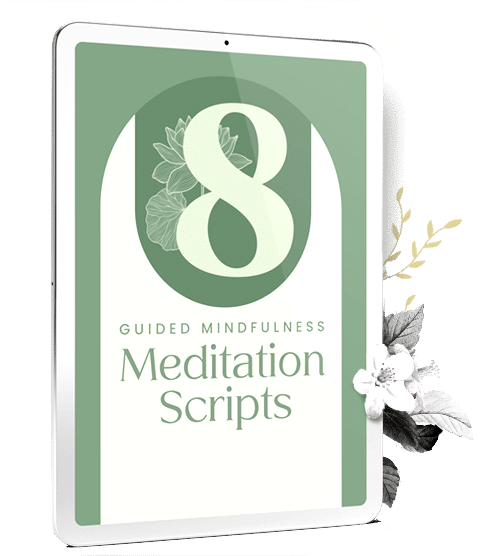With the number of hours we spend in slumber on the decline, more and more people are turning towards alternative methods of improving sleep. From guided sleep meditations to simple mindfulness tools designed to enhance relaxation, the pool of free sleep tools for us to explore is vast. Never before have we had such valuable resources at our fingertips.
It all comes at a time when it’s unquestionably needed. In 1942, 84% of Americans got an average of 7 to 9 hours of sleep per night. Fast forward seven decades and findings suggest that this percentage has slipped to 59%. With stress and anxiety being one of the primary reasons we struggle to fall asleep at night, it makes sense that guided meditations and other mindfulness techniques are being increasingly sought out.
But it begs the question: are guided sleep meditations really effective? If so, how do they support us? And how do we go about exploring meditation for sleep?
In this comprehensive guide to sleep meditations, we’ll explore:
1. Is Meditation Good for Sleep?
2. How Do I Meditate to Sleep?
3. 5 Meditations for Sleep
Is Meditation Good for Sleep?
While most of us can intuitively sense that meditation and mindfulness practice is beneficial for enhancing relaxation and rest, science is now backing it up. Over the past few decades, more attention is being given to ancient meditation techniques, unveiling the relaxation mechanisms of these practices.
To gain a better sense of just how meditation benefits both sleep quality and quantity, we can begin by looking at what meditation is and what its overall benefits are.

The Basic Benefits of Meditation
Meditation is a practice that uses a specific technique (such as mindfulness, focused attention, or mantra repetition) to enhance attention or awareness, increase clarity, or enhance mental and emotional stability. Each technique is slightly different, though they often achieve similar outcomes.
Some of the benefits of meditation that are now been shown through scientific studies include:
In addition to all of these, many studies have focused on the direct effect of meditation on sleep. The findings? That meditation is indeed a supporter of a good night’s sleep.
How Meditation Improves Sleep
It all sounds encouraging, but how does it work exactly? There are a few different mechanisms that are believed to underpin the improvements in sleep when we practice meditation. Some of these mechanisms include:

1. Reducing the stress response
First and foremost, meditation helps to reduce the body’s stress response by initiating the counter ‘relaxation response’. As the breath and body soften through meditation (i.e. breathing practices and body scans), stress hormones such as cortisol begin to balance out and both body and mind move toward equilibrium. Cortisol levels must be low for sleep to be initiated, so easing stress before bed is crucial to attaining a good night’s sleep.
2. Boosting the production of sleep hormones
Cortisol is not the only hormone affected by meditation. Melatonin, the ‘sleep hormone’, also comes into balance as we practice. In fact, meditation increases the body’s production of melatonin, making it easier for us to drift off to sleep. So as cortisol lessens and melatonin production increases, it makes sense that we find a greater ability to rest with ease.
3. Increasing self-awareness and emotion regulation
Meditation practice also helps to increase our sense of self-awareness, reducing the weight of difficult emotions. Mindfulness of our emotions helps us to create a bit of space between our core self and our feelings, giving us greater insight into the waves that move through us. As we become more aware of these, it becomes easier to step beyond ruminating thoughts that keep us wide awake.
4. Alleviating the perception of pain
As mentioned, meditation has been found to reduce our experience of pain. This is one mechanism at play for those that struggle to sleep because of physical discomfort. Through body scan practices and mindful awareness of our physical sensations, we slowly develop a new relationship with painful experiences. Meditation also reduces inflammation, which may be a contributing factor in our discomfort.
How Do I Meditate to Sleep?
Meditating to fall asleep is simple – but not necessarily easy. Most of us have become so accustomed to crawling into bed alongside our ruminating thoughts that breaking this habit can take time. With compassion, patience, and true presence, we can start to break the cycles that have stood in the way of good rest for too long now.
Meditating to sleep requires both a bit of mindful preparation as well as specific techniques and tools. Setting the stage is just as important as what we do once we close our eyes, so taking the time to prepare goes a long way.

Setting the Stage
Before we get into bed, we can prepare for meditation by doing whatever we can to calm and quiet the mind. Some specific techniques to consider include:
For each of us, setting the stage will look a bit different. It might also require commitment to put work away earlier in the evening, to take some space for ourselves, or to address nighttime eating habits. Since the root causes of sleep issues are unique for each of us, so too are the remedies.
Techniques for Bedtime Meditation
Most meditation is beneficial for sleep, though some may be more useful than others. Relaxation and mindfulness techniques are perhaps better suited than focused attention or mantra repetition (though if either of these has been helpful for you, continue to explore it).
Some specific mindfulness exercises and relaxation techniques you might explore include:

1. Belly breathing
Diaphragmatic breathing, or belly breathing, is a direct way of initiating the relaxation response. It can be practiced by placing one hand on the belly and one hand on the chest while lying down. As you inhale, let most of the rise come through the hand that rests on your stomach; and as you exhale, let the largest drop also be in the stomach. The upper hand (the hand on the chest) might move a little, but try to let most of the movement be in the stomach.
2. Body scan
A gentle body scan is also another wonderful practice to explore while in bed. Resting on your back, draw your close-eyed awareness to your forehead, witnessing and releasing any tension held there. Continue downward, paying close attention to the muscles around the eyes, the jaw, the shoulders, the stomach, and the hips. Move slowly, taking a deep breath into each body part you pass and softening with each full exhale. When you are done, hold your entire body in your awareness, grounding through your breath.
3. Gratitude practice
Taking time to consciously note what we have to be thankful for can also help to ease the stress response. It retrains the mind to see the positive over the negative, and so it’s a useful way of creating a mindset shift. To practice in bed, rest on your back and begin to consider all the things you have to be grateful for – beginning with your direct, most intimate experience. This can include your breath, your physical body, the bed that supports you, the roof over your head, and the warmth of your home. Continue to expand outwards until the mind tires or quiets. Then, practice mindful breath awareness to settle even further.
5 Meditations for Sleep
In addition to the outlined practices, a guided sleep meditation or meditation music for sleep are excellent resources worth exploring. When it’s difficult to focus and soften the mind, guided recordings support and encourage our bedtime practice. When you find a meditation for sleep that suits you, be sure to save it so you can spend less time in front of your device the next time you require it.
There are infinite resources to explore, but some you might consider include:

This track by Jason Stephenson includes soothing sounds of a crackling fire and gentle rain. It opens with 22 minutes of guided meditation, allowing listeners to drift off alongside rainfall and crackling log sounds afterwards.

This meditation music for sleep is a soft and soothing journey through the seven solfeggio frequencies that help to balance the seven major chakras. Without words, this recording acts as a peaceful backdrop as you drift to sleep.

This track is another guided recording that offers a soothing, otherworldly visualization. After taking a trip into the stars, listeners are guided slowly and naturally into slumber.

Another piece of meditation music for sleep, this track is designed to help liberate guilt and fear and ease any difficulties we might be experiencing with daily life. It includes binaural beats with a 396 Hz frequency.

Last but not least, this soft and soothing sleep track, created by Peder B. Helland, provides a beautiful, relaxing backdrop to ease the mind alongside. As you listen to the track, you might pair it with your own meditation practice.
Whatever technique or recording you choose to explore, remember to be patient with both mind and body as you practice. As you support your body in relaxing, you’ll find it yearns to go there quite innately. The more you practice, the more effortless deep rest will become. Take it breath by breath and you may be surprised at how quickly the body falls into slumber.
References:
- 1https://news.gallup.com/poll/166553/less-recommended-amount-sleep.aspx
- 2https://onlinelibrary.wiley.com/doi/abs/10.1002/da.21964
- 3https://www.sciencedirect.com/science/article/pii/S0889159112004758
- 4https://www.ncbi.nlm.nih.gov/pubmed/25141355
- 5https://www.ncbi.nlm.nih.gov/pmc/articles/PMC3090218/
- 6https://link.springer.com/article/10.1007/s12671-012-0115-4
- 7https://link.springer.com/article/10.3758/CABN.7.2.109#page-1
- 8https://www.ncbi.nlm.nih.gov/pubmed/25390009
- 9https://www.ncbi.nlm.nih.gov/pmc/articles/PMC3328970/













